Discover 15 hidden attractions, cool sights, and unusual things to do in Worcester (United Kingdom). Don't miss out on these must-see attractions: Witley Court, Worcester Cathedral, and Worcester Racecourse. Also, be sure to include Sixways Stadium in your itinerary.
Below, you can find the list of the most amazing places you should visit in Worcester (England).
Table of Contents
Witley Court
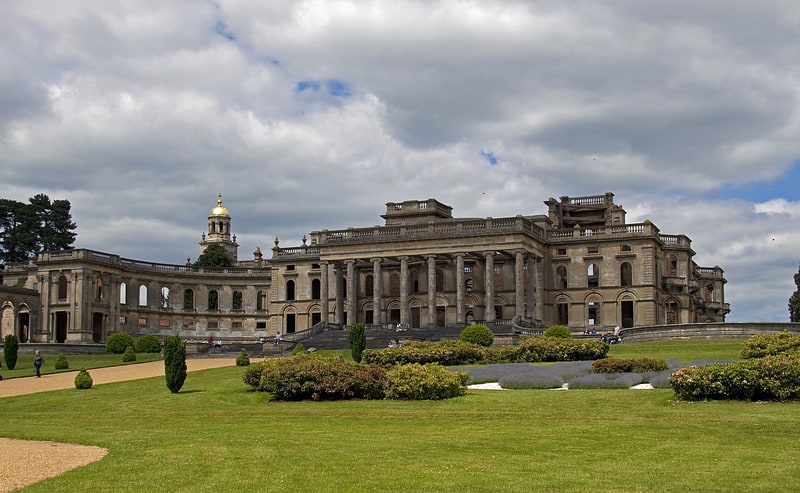
Manor house in England. Witley Court, Great Witley, Worcestershire, England is a ruined Italianate mansion. Built for the Foleys in the seventeenth century on the site of a former manor house, it was enormously expanded in the early nineteenth century by the architect John Nash for Thomas Foley, 3rd Baron Foley. The estate was later sold to the Earls of Dudley, who undertook a second massive reconstruction in the mid-19th century, employing the architect Samuel Daukes to create one of the great palaces of Victorian and Edwardian England.
The declining fortune of the Dudleys saw the sale of the court after the First World War to a Kidderminster carpet manufacturer. In 1937 a major fire caused great damage to the court, the estate was broken up and sold and the house was subsequently stripped of its fittings and furnishings. Forty years of decay followed before the house and grounds were taken into the care of The Department of the Environment in 1972. Since that point, significant restoration and stabilisation have secured the house as a spectacular ruin.
Witley Court, and the attached Church of St Michael and All Angels, are both Grade I listed buildings[1]
Address: Worcester Road, WR6 6JT Great Witley
Worcester Cathedral
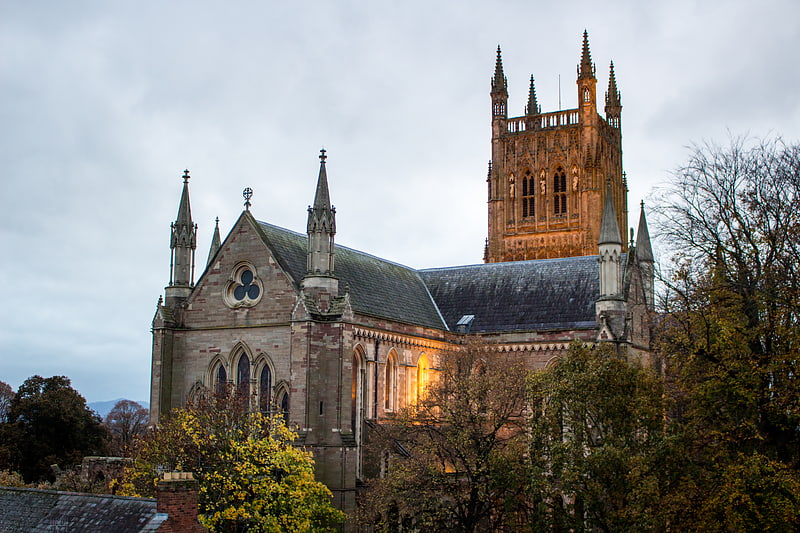
Medieval building with King John's tomb. Worcester Cathedral is an Anglican cathedral in Worcester, England, situated on a bank overlooking the River Severn. It is the seat of the Bishop of Worcester. Its official name is the Cathedral Church of Christ and the Blessed Mary the Virgin, of Worcester. The present cathedral church was built between 1084 and 1504, and represents every style of English architecture from Norman to Perpendicular Gothic. It is famous for its Norman crypt and unique chapter house, its unusual Transitional Gothic bays, its fine woodwork, and its "exquisite" central tower, which is of particularly fine proportions. The cathedral contains the tombs of King John and Prince Arthur.[2]
Address: 8 College Yard, WR1 2LA Worcester
Worcester Racecourse

Sports venue in Worcester, England. Worcester Racecourse is a thoroughbred horse racing venue located in the city of Worcester, Worcestershire, England. Horse racing has taken place here since at least 1718. It staged Flat racing until 1966 but has since staged National Hunt racing only.
It is popularly known by Worcester residents as 'Pitchcroft' and is just short of 100 acres. From 1893 the Worcester Rugby Club played on ground enclosed by the racecourse for a number of years. In 1902 Berwick Rangers and Worcester Rovers football clubs amalgamated taking the present name of Worcester City F.C. playing on an enclosed area of the racecourse called Severn Terrace (behind the present Swan Theatre) until the start of the 1905 season.
The course is laid out as a left handed oval circuit of about 13 furlongs (approximately 2,615 metres) in length, with nine fences (five down the back straight and four in the home straight) and situated by the east bank of the River Severn and the north side of Worcester Bridge.
During the 2007 floods, the racecourse was inundated and all the fixtures after June 30 had to be cancelled.[3]
Address: Worcester Racecourse Grand Stand Road, WR1 3EJ Worcester
Sixways Stadium
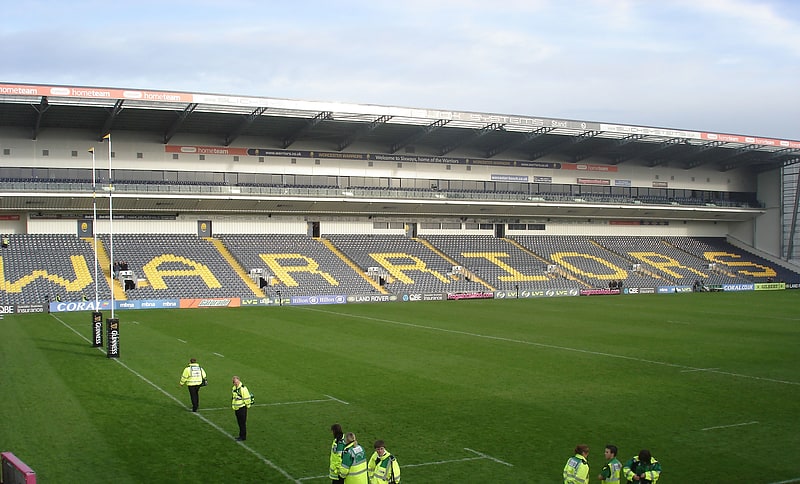
Stadium in England. Sixways Stadium is a stadium in Worcester, England. It is currently used for rugby union and association football matches and is the home stadium of Premiership Rugby club Worcester Warriors and Hellenic League Division One football side Worcester Raiders. The stadium is able to hold 11,499 with parking for 1,000 cars, Sixways has 60 modern meeting and event rooms. The ground opened in 1975 and is located off junction 6 of the M5 motorway, which splits into six directions, hence the name Sixways. The Stadium commenced building on the site of the old 3rd team pitch and club house after a lottery grant in 1998.
On 7 April 2016 it was announced that Sixways' pitch would be converted to the latest technology artificial grass ahead of the 2016–17 season. Sixways would become the third premiership venue with an artificial pitch after Barnet Copthall stadium and Kingston Park but the first to feature organic infill rather than rubber crumb.[4]
Address: Sixways Stadium Warriors Way, WR3 8ZE Worcester
Worcester Guildhall
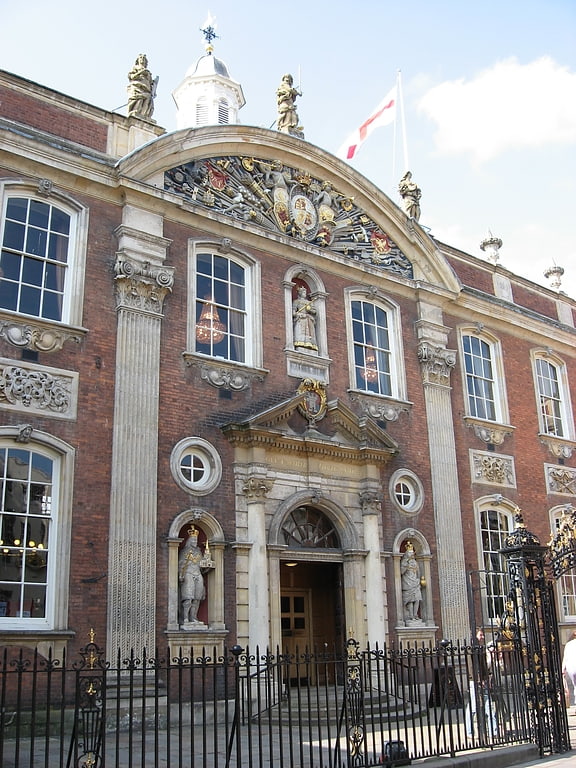
The Worcester Guildhall is a municipal building in the High Street, Worcester, England. It is a Grade I listed building.[5]
Address: 81A High Street, WR1 2EY Worcester
The Commandery
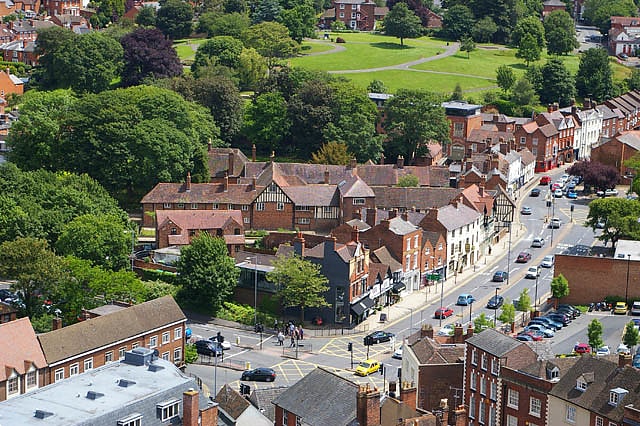
Museum in Worcester, England. The Commandery is a historic building open to visitors and located in the city of Worcester, England. It opened as a museum in 1977 and was for a while the only museum in England dedicated solely to the Civil Wars. The Commandery ceased to be a Civil War museum when it reopened to the public in May 2007, having undergone a year and a half of refurbishments and reinterpretation jointly funded by the Heritage Lottery Fund and Worcester City Council, who own the building. It is a Grade I listed building.[6]
Address: Sidbury, WR1 2HU, Worcester, Worcester
Whittington Tump
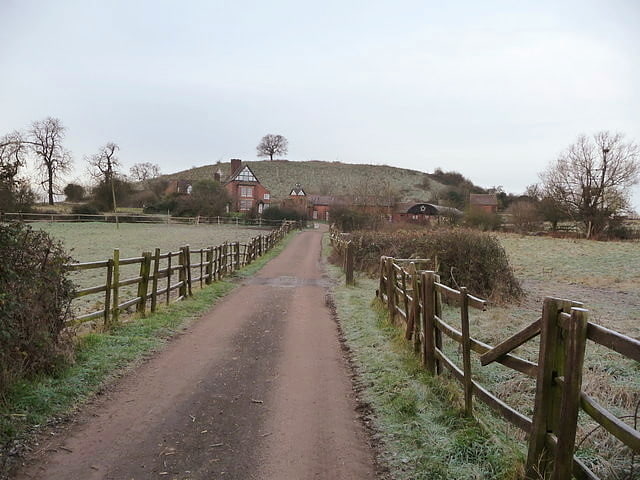
Castle in Worcester, England. Whittington Tump or Crookbarrow Hill is a partly artificial mound in central Worcestershire, England. There is evidence of prehistoric activity at the site and may have been used as a religious site or burial mound. A Romano-British settlement was established nearby in the early 2nd century AD but was apparently abandoned by the 4th century. An Anglo-Saxon enclosure was established on Whittington Tump by the 7th century and during the mediaeval period it is thought to have been the site of a motte castle. Crookbarrow Manor was established at the foot of the hill by 1314 and the site, including the former motte, was given over to agricultural use. The site was listed as a scheduled monument in 1923 and is a landmark for motorists on the nearby M5 motorway.[7]
Worcester City Art Gallery & Museum
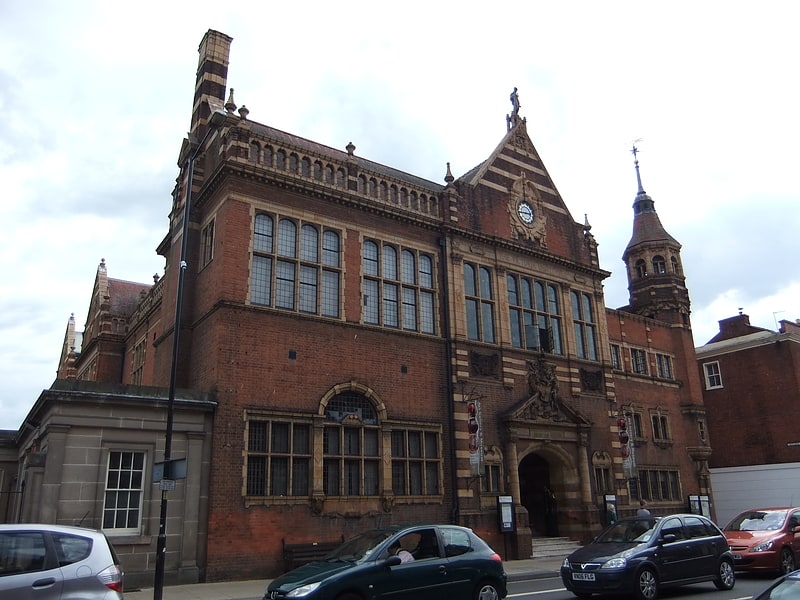
The Worcester City Art Gallery & Museum is an art gallery and local museum in Worcester, the county town of Worcestershire, England.[8]
Address: Worcester City Museum & Art Gallery Foregate Street, WR1 1DT Worcester
Museum of Royal Worcester

Museum in Worcester, England. The Museum of Royal Worcester is a ceramics museum located in the Royal Worcester porcelain factory's former site in Worcester, England.[9]
Address: Worcester Porcelain Museum Severn Street, WR1 2ND Worcester
Swan Theatre
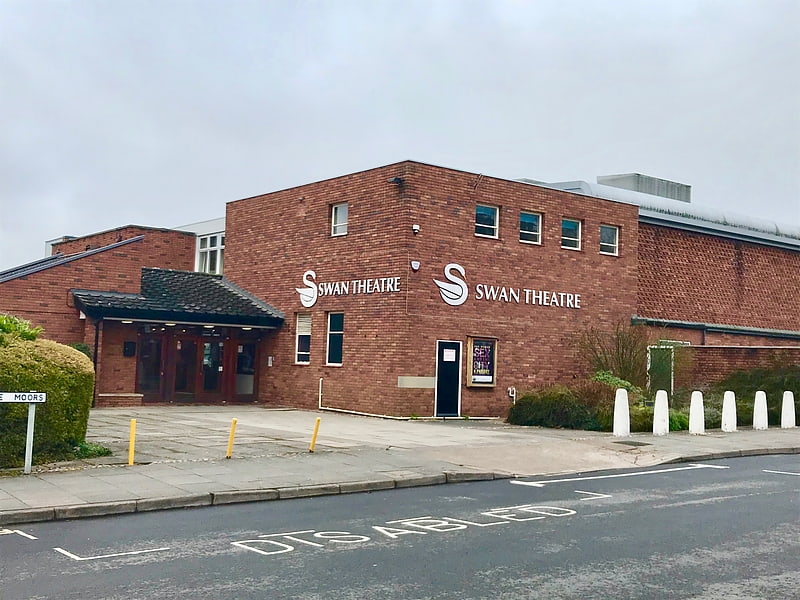
Theatre in Worcester, England. The Swan Theatre is a theatre currently run by the Worcester Theatres Charitable Trust in Worcester, England. It is the official residence of the Worcester Repertory Company, Swan Youth Theatre and Young Rep. It stages drama, music, dance and spoken word as well as being hired out to local, regional and national amateur groups. It was built in 1965 and was designed by Henry Gorst. The Swan Theatre was built a decade after the demolition of the Worcester Theatre Royal, which was condemned due to fire damage.
The theatre has undergone two major refurbishments since it was built. One in the late 1970s which added a studio theatre, office spaces and workshop space and another in 2009. The 2009 refurbishment installed air-handling in the theatre's main house as well as the removal of asbestos and the inclusion of a public balcony in the bar and foyer area. In addition to the 350 seat main house auditorium the theatre has a 50 seat studio space, The Vesta Tilley Studio, named after Music Hall star and Worcester born performer, Vesta Tilley.[10]
Address: The Moors, WR1 3ED Worcester
Worcester city walls

Worcester's city walls are a sequence of defensive structures built around the city of Worcester in England between the 1st and 17th centuries. The first walls to be built around Worcester were constructed by the Romans. These early walls lasted beyond the fall of the Empire, and the defences encouraged several early Christian foundations to establish themselves in Worcester during the troubled 6th and 7th centuries. The Anglo-Saxons expanded Worcester in the 890s, forming a new walled, planned city, called a burh. The burh utilised the southern stretches of the old Roman walls, but pushed further north to enclose a much larger area. The Anglo-Saxon city walls were maintained by a share of taxes on a local market and streets, in an agreement reinforced by a royal charter.
After the Norman conquest of England in the 11th century a motte and bailey castle was constructed on the south side of the city, but the Norman rulers continued to use the older burh walls, despite the city having expanded beyond these defences in the north and south-east. During the years of the Anarchy in the 1140s, Worcester was successfully attacked several times; after the war a new city wall was built to improve the city's defences. The new walls, completed by the early 13th century, were constructed of stone and had three main gates. They were maintained in good condition into the 17th century.
During the English Civil War in the 1640s the old medieval walls were reinforced with modern earthwork bastions and an outlying fort, called a sconce. Worcester changed hands several times during the conflict, and after the war ended the newer fortifications were dismantled. During the 18th century the older medieval stone walls and gatehouses were sold and mostly destroyed: by the 20th century, few parts survived. Post-war archaeology in the 1950s and 1960s and construction work in the 1970s revealed previously hidden stretches of the wall, and in the 21st century plans have been drawn up to improve the conservation and maintenance of this historic monument.[11]
Worcester Woods Country Park
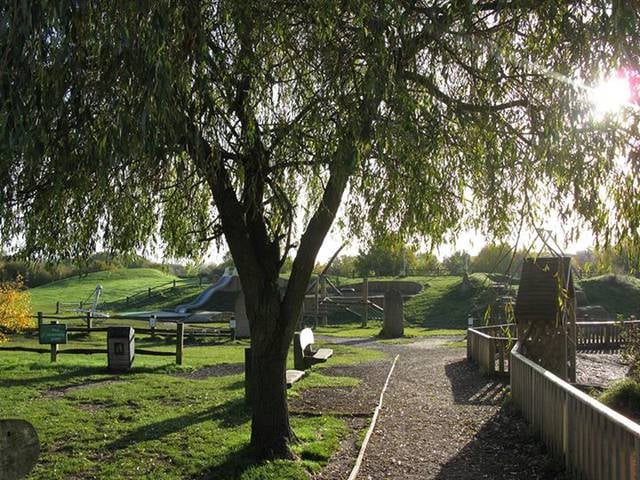
Country park in Worcester, England. Worcester Woods Country Park is a country park in Worcester, Worcestershire, England.[12]
Address: Worcester Countryside Centre Wildwood Drive, WR5 2LG Worcester
Gheluvelt Park
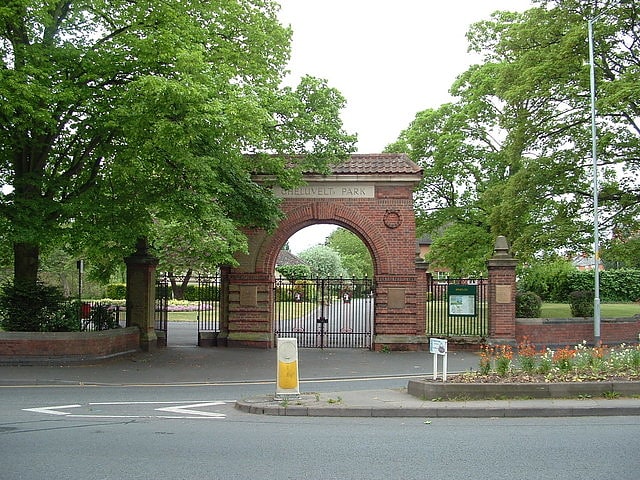
Park in Worcester, England. Gheluvelt Park is a public park in Worcester, England, which opened on 17 June 1922 to commemorate the Worcestershire Regiment's 2nd Battalion after their part in Battle of Gheluvelt, a World War I battle that took place on 31 October 1914 in Gheluvelt, Belgium. It was opened by Field Marshal John French, 1st Earl of Ypres, who stated, "on that day the 2nd Worcesters saved the British Empire." A plaque inside the park commemorates Captain Gerald Ernest Lea, who died on 15 September 1914 while commanding D. Company of the 2nd Battalion.
The park is located in Worcester, along the A449 (Barbourne Road) and stretches across to the River Severn. The Barbourne Brook, which leads to the Severn, feeds a duck pond within which is a bandstand. The park contains a children's play area and a supervised paddling pool. A conservation site is managed by the Duckworth Worcestershire Trust and, following renovations to the old Victorian Pump House, the Environment Centre provides information about environmental issues as well as sustainability. The Friends of Gheluvelt Park organisation helps maintain the parks and organise events such as Carols in the Park and a St George's Day celebration. A significant area of the park, including the children's play area, was flooded by the Severn and the Barbourne Brook during the 2007 United Kingdom floods in July.
Gheluvelt Park has received £850,000 from the Heritage Lottery Fund, in order to improve the park. A new play area has been created, a Splash Pad built for toddlers to early teens, the railings have been reinstated along Barbourne Road, and the bandstand has been renovated. Recently, a sculpture costing £33,000 was installed, to symbolise the fallen soldiers, and a funding application has been submitted for outdoor fitness equipment for adults, (2011), including six exercise units and also two concrete table tennis tables. Funding has also been applied for, for a community "Fitness event" in Autumn 2011.[13]
Address: Barbourne Road, Worcester
Greyfriars
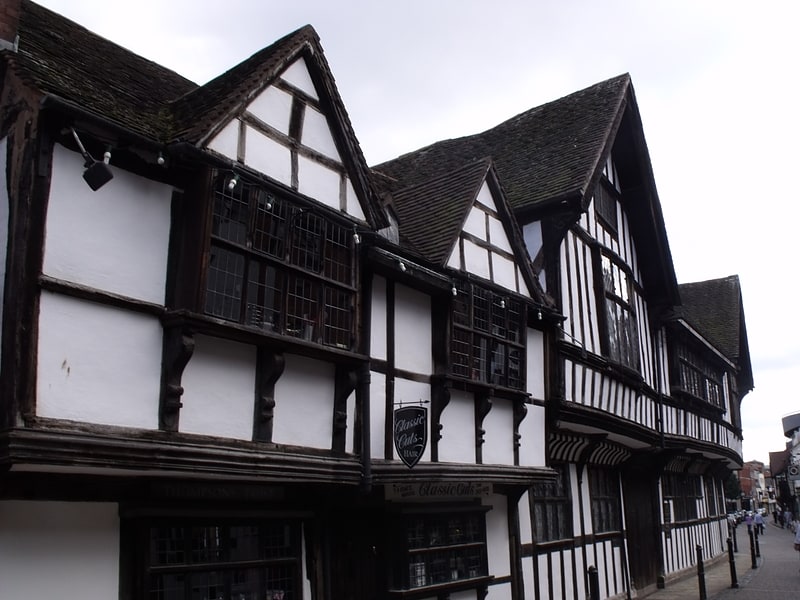
Greyfriars, Worcester is a Grade I listed building in Worcester, England. Its location near to a former friary of the Franciscan order of Greyfriars has in the past led to speculation that it was constructed as their guest house, but it is now believed to have been built as a house and brew-house c.1485 for Thomas Grene, brewer and High Bailiff of Worcester from 1493-1497. It has been in the ownership of the National Trust since 1966.[14]
Address: The Greyfriars Friar Street, WR1 2LZ Worcester
St Swithun's Church
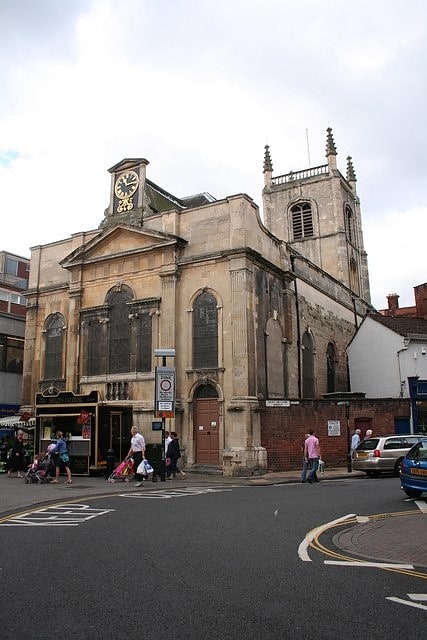
Church in Worcester, England. St Swithun's Church is a redundant Anglican church in the city of Worcester, Worcestershire, England. It is recorded in the National Heritage List for England as a designated Grade I listed building, and is under the care of the Churches Conservation Trust. The church is considered to be "one of the best preserved examples of an early Georgian church in England". Clifton-Taylor includes the church in his list of 'best' English parish churches.[15]
Address: High St, WR1 2RH Worcester